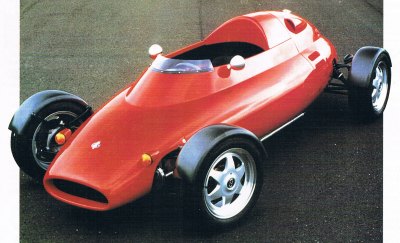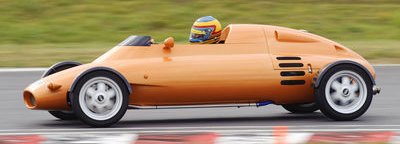 The part-time sports car specialist was founded by former racing driver Chris Craft in the early 1990s, and the Rocket was his first (and only) project. The car was not designed by Craft himself, but by his good friend Gordon Murray - yes, the famed Gordon Murray. Having retired from Formula One racing, in which his cars had won five world championships, Murray started devoting himself to road car design. Rocket was one of his first designs put to production. Another was the mighty McLaren F1 supercar. Interestingly, the philosophy of Rocket was even closer to Formula One race cars than McLaren F1 was. Not only looked like a Formula race car - with a tubular body, exposed wheels and suspension linkages, open cockpit and no windscreen - its chassis structure was also inspired by Formula race cars. The engine was used as stressed member to support the rear suspensions like F1 race cars. The narrow, cigar-shaped chassis was spaceframe made of nickel-bronze, covered with light alloy inner panels and glass-fiber outer panels. Power came from a motorcycle engine, i.e. Yamaha FZR1000's 1002 c.c. straight-4, with 5 valves per cylinder. Like the superbike, maximum power of 143 hp arrived at sky-high 10,500 rpm, and 77 lbft torque at 8,500 rpm. The engine mated to a 5-speed sequential Yamaha gearbox, and then to a bespoke final drive which incorporated limited-slip differential as well as a reverse gear, since the motorcycle gearbox had no reverse. As you might have predicted, Rocket was extremely light - only 400 kg. This gave it a very good power-to-weight ratio. But most important is that the ultra-lightweight benefited handling and braking. As commented by Autocar magazine, Rocket rewrote any experience of sports car driving with its extremely agile handling. The unassisted steering was ultra-quick and very communicative. The double-wishbones suspensions provided stability yet good ride. It was very quick in corners yet easy to handle. Excluding formula race cars, nothing could compare with it, not even a Caterham Seven. Part of the handling excellence was contributed by the brakes. You won't predict such a flyweight to use such high-specification brakes - front ventilated and cross-drilled discs with 4-piston Brembo calipers, rear cross-drilled discs with 2-piston calipers, also by Brembo. As described by Gordon Murray, "It is the only car I know that you can thrash round a circuit all day without so much as a wisp of smoke from the brakes, and then jump in and drive it home". Rocket was available to special order until 1998. Around 46 cars were built. In 2007, Chris Craft and his son introduced the series 2 car, which came with a 171hp Yamaha engine and fine tuning to eveyrthing. No matter series 1 or 2, their prices were very high, about the same as a Porsche 911 Carrera. The car was virtually impractical in any sense. It had no weather protection, no boot and no equipment. Its 1+1 seating was designed to punish adult passenger. Still, driving the Rocket was a worthy experience to car enthusiasts. It was never intended to serve for transportation. Intead, it was designed to be driven purely for fun.  |